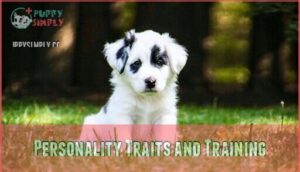This site is supported by our readers. We may earn a commission, at no cost to you, if you purchase through links.
 You’ll find the great pyrenees pitbull mix combines two powerhouse breeds into one impressive companion.
You’ll find the great pyrenees pitbull mix combines two powerhouse breeds into one impressive companion.
This hybrid typically weighs 50-60 pounds and inherits the Pyrenees’ protective instincts with the Pitbull’s unwavering loyalty to family.
They’re naturally observant guardians who’ll watch over your home while showering you with affection.
However, their independent streak means they need consistent training from day one—think of them as the strong-willed teenager of the dog world who needs clear boundaries.
These dogs aren’t for first-time owners, but experienced handlers will appreciate their intelligence and devotion.
Understanding their unique care requirements can make all the difference in raising a well-balanced companion.
Table Of Contents
- Key Takeaways
- Great Pyrenees Pitbull Mix
- Size and Temperament
- Health Concerns and Care
- Lifespan and Breed Characteristics
- Finding and Raising a Puppy
- Frequently Asked Questions (FAQs)
- What is the personality of a Great Pyrenees pitbull mix?
- What is the lifespan of a Pyrenees pitbull?
- Are Great Pyrenees mix good dogs?
- Is a Great Pyrenees bite stronger than a pitbull?
- Do Great Pyrenees Pitbull mixes bark excessively?
- Are they good with other pets?
- What climate conditions suit them best?
- How much daily exercise do they need?
- Can they live in apartments comfortably?
- Conclusion
Key Takeaways
- You’ll need experience with large, strong-willed dogs since this 50-120 pound mix combines protective instincts with stubborn independence that requires consistent training and firm boundaries from day one.
- Expect significant grooming and shedding challenges as they can inherit either a short Pitbull coat or a thick Great Pyrenees double coat, with heavy shedders requiring daily brushing and specialized tools.
- They’re natural guardians who need proper socialization to balance their protective nature with family life, making them excellent watchdogs but requiring early training to prevent overprotectiveness with strangers.
- Plan for 10-14 years and substantial ongoing costs including $60-80 monthly food expenses, $1,200 annual vet bills, and high exercise needs that make apartment living unsuitable for this energetic hybrid.
Great Pyrenees Pitbull Mix
You’ll discover an impressive crossbreed when you meet a Great Pyrenees Pitbull mix, combining the gentle giant nature of a livestock guardian with the loyal strength of a terrier.
This unique hybrid brings together two distinct bloodlines, creating a dog that’s both protective and affectionate with proper training and socialization.
Origin and History
When you’re looking at the great pyrenees pitbull mix, you’re seeing a relatively new hybrid that emerged from Purpose Bred crossbreeding between two distinct lineages.
This Hybrid Development combines European pastoral heritage with American terrier ancestry, creating mixed breed dogs with unique characteristics.
The breed’s Historical Timeline includes:
- Great Pyrenees ancestry from French-Spanish mountain regions as livestock guardians
- American Pitbull Terrier development in the US for companionship roles
- Modern crossbreeding by Early Breeders seeking balanced protective traits
This Breed Ancestry blend represents intentional designer dog creation. These dogs are known for their strong guarding instincts.
Physical Characteristics
Combining two distinct breeds creates a striking appearance in your great pyrenees pitbull mix.
You’ll notice varied coat color patterns ranging from solid white to brindle combinations.
The body shape typically shows moderate muscularity between the Pyrenees’ sturdy frame and Pitbull’s athletic build.
Head structure varies, while paw size generally falls within large dog breeds standards for this pyrenees pitbull size hybrid.
Some mixes share similar traits with the American Bulldog Great Pyrenees.
Coat Types and Shedding
Your Great Pyrenees mix’s coat genetics create a fascinating lottery. This large dog breeds hybrid inherits either the Pitbull’s short coat or the Great Pyrenees’ thick double layer, directly impacting pyrenees pitbull shedding patterns.
Your mix’s coat is a genetic surprise package—you might get a sleek terrier coat or a fluffy mountain dog mane.
Their double coat means they experience consistent year-round shedding.
Shedding frequency varies dramatically:
- Double-coated mixes – Year-round shedding with intense seasonal shedding periods
- Single-coated types – Moderate, consistent fur loss throughout the year
- Grooming tools needed – Undercoat rakes for heavy shedders, weekly brushing for others
- Hypoallergenic claims – This pitbull pyrenees mix isn’t hypoallergenic regardless of coat type
Size and Temperament
When you bring home a Great Pyrenees Pitbull mix, you’re getting a dog that can weigh anywhere from 60 to 120 pounds and stand 20 to 32 inches tall.
This mixed breed combines the gentle giant nature of the Great Pyrenees with the loyal, energetic personality of the Pitbull, creating a dog that’s both protective and affectionate with proper training.
Height and Weight Range
Your great pyrenees mix will typically reach an Adult Size between 20-32 inches tall and weigh 60-120 pounds.
Genetic Influence from both parents creates significant variation in Growth Rate and final dimensions.
Parental Height strongly affects your pyrenees pitbull’s ultimate size, with most pyrenees pitbull puppies reaching full Weight Standards by 18-24 months.
Given their lineage, some mixes may share traits with other large white breeds known for their gentle nature.
| Size Category | Height Range | Weight Range |
|---|---|---|
| Small | 20-24 inches | 60-80 pounds |
| Medium | 25-28 inches | 81-100 pounds |
| Large | 29-32 inches | 101-120 pounds |
Personality Traits and Training
Your pyrenees pitbull displays remarkable intelligence levels but comes with an independent streak that’ll test your leadership skills.
This mix temperament combines loyalty with stubbornness, requiring consistent training methods and early socialization tips.
Positive reinforcement works best—punishment triggers defensive behaviors, and with patience, you can create well-mannered family dogs, although expect some behavioral issues like territorial patrolling, but firm boundaries can help.
Family Pet Suitability
Understanding whether this mix suits your family depends on several key factors.
These dogs can make wonderful family companions with proper preparation and commitment.
Key Family Considerations:
- Child Compatibility – Best with older children who understand boundaries; their size and guarding instincts require supervision around toddlers
- Home Environment – Needs spacious yards and secure fencing; apartment living isn’t ideal for this energetic hybrid
- Activity Level – Requires active families who enjoy daily walks, hiking, and interactive play sessions
- Training Ease – Responds well to consistent, positive reinforcement but needs experienced handlers familiar with pyrenees pitbull temperament
Their protective nature makes them excellent family dogs when properly socialized.
Health Concerns and Care
Your Great Pyrenees Pitbull mix will need regular health monitoring since both parent breeds carry specific genetic concerns that can affect your dog’s wellbeing.
Understanding these potential issues and establishing proper care routines early will help you keep your mixed breed companion healthy and happy throughout their life.
Common Health Issues
Your furry friend faces several health challenges that come with the territory.
Hip Dysplasia tops the list, causing joint pain and mobility issues.
Bloat Risk is serious in deep-chested dogs like this mix.
Eye Problems, Heart Conditions, and Skin Allergies round out common concerns.
Understanding pyrenees pitbull health helps you spot early warning signs and maintain your dog’s pyrenees pitbull lifespan through preventive care, which is crucial for managing Hip Dysplasia.
Nutrition and Exercise Needs
Beyond basic kibble, your Great Pyrenees Pitbull mix needs carefully balanced Adult Nutrition with proper Calorie Requirements based on size and activity level.
Puppy Exercise should be limited to prevent joint damage, while adults need moderate daily activity.
Senior Activity decreases naturally, requiring adjusted portions.
To promote optimal health, consider nutritional products for dogs. Dietary Supplements may support pyrenees pitbull health, but consult your vet first.
Proper nutrition supports pyrenees pitbull lifespan and training success, and helps to guarantee a healthy life.
Grooming Requirements
Your Great Pyrenees Pitbull mix needs regular coat maintenance to stay healthy and comfortable.
Brushing frequency should be 2-3 times weekly, increasing during shedding seasons. Bathing needs are minimal—every 6-8 weeks unless dirty.
Monthly nail trimming prevents overgrowth, while weekly ear cleaning reduces infection risk.
A quality brush can assist with effective coat maintenance. This grooming routine keeps your pup looking great while supporting their pyrenees pitbull health.
Lifespan and Breed Characteristics
When you’re considering a Great Pyrenees Pitbull mix, you’ll want to understand their typical lifespan ranges from 10-14 years, influenced by both parent breeds’ genetics.
This hybrid combines the Great Pyrenees’ guardian instincts with the Pitbull’s loyalty, creating a dog that’s both protective and affectionate with proper care.
Average Lifespan and Aging
Time brings wisdom to every Great Pyrenees Pitbull mix, with Life Expectancy typically ranging 10-14 years.
You’ll notice Aging Signs around seven years, when your companion enters their golden chapter and deserves extra attention.
- Watch for gray facial fur and decreased energy levels as early indicators
- Schedule bi-annual vet checkups to catch Common Ailments like hip dysplasia early
- Provide orthopedic beds and joint supplements for Senior Care comfort
- Monitor weight gain since older dogs need fewer calories but consistent exercise
- Discuss End-of-Life planning with your veterinarian when quality declines substantially
Breed Strengths and Weaknesses
Understanding your mixed breed’s strengths and weaknesses helps set realistic expectations.
These dogs inherit impressive guardian instincts and loyalty from their Great Pyrenees lineage, while gaining athleticism from their Pitbull heritage.
However, this combination can create Training Challenges requiring experienced handlers.
Considering their size, this is a key factor in planning for their long-term care, as large breeds lifespan can be a vital factor.
| Strengths | Weaknesses |
|---|---|
| Natural protective instincts | Temperament Risks with strangers |
| High intelligence and trainability | Exercise Limitations due to size |
| Strong family bonds | Inherited Traits causing stubbornness |
| Athletic and versatile | Health Predispositions from both breeds |
Comparison to Purebred Parents
Compared to their purebred parents, these hybrids display amplified traits.
Size Inheritance creates dogs falling between both breeds, while Temperament Blend intensifies protective instincts beyond typical Great Pyrenees or Pitbulls.
Health Predispositions combine risks from both lineages, requiring vigilant care.
Appearance Variations range dramatically—some favor Pyrenees’ fluffy coats, others Pitbull’s sleek build.
Training Differences emerge through heightened stubbornness, making consistent methods essential for success.
Finding and Raising a Puppy
Getting a Great Pyrenees Pitbull mix puppy requires careful research since this isn’t a common crossbreed you’ll find at every breeder or shelter.
You’ll want to start your search early and prepare for the unique challenges of raising a dog that combines guardian instincts with high energy levels.
Reputable Breeders and Adoption
Finding reputable pyrenees pitbull breeders proves challenging since ethical breeding of this mix remains uncommon.
Your best bet is to focus on great pyrenees pitbull rescue organizations like National Great Pyrenees Rescue, which lists 100+ adoptable dogs daily.
The adoption process requires applications, home visits, and vet checks, but adopting pyrenees pitbull mixes costs $300-$500 versus $1,000+ from breeders.
Watch for breeder red flags like missing health guarantees covering both parent breeds’ genetic issues.
Puppy Socialization and Training
Once you’ve found your Great Pyrenees Pitbull mix puppy, start Early Socialization immediately.
These powerful dogs need consistent pyrenees pitbull training focusing on Basic Obedience and Bite Inhibition.
Practice active listening during training sessions, providing clear feedback and Leadership through Crate Training.
To facilitate this process, consider purchasing puppy socialization products.
Don’t forget Leash Manners—your future 80-pound companion will thank you when they’re not dragging you down the street like a sled dog.
Cost and Ongoing Expenses
Budgeting for a Great Pyrenees Pitbull mix means preparing for significant initial costs and ongoing expenses.
You’ll face $800-2,000 in puppy fees, plus monthly food expenses around $60-80.
Vet bills can reach $1,200 annually, while grooming costs average $75 per session, and training fees range from $200-500 for basic classes, making this breed a considerable financial commitment.
Initial expenses can also include microchip identification costs, which is an essential part of owning a Great Pyrenees Pitbull mix.
Frequently Asked Questions (FAQs)
What is the personality of a Great Pyrenees pitbull mix?
Jake’s Great Pyrenees-pitbull mix is gentle with kids but protective of strangers.
You’ll find this crossbreed combines the Pyrenees’ calm guardian instincts with the pitbull’s loyal, energetic nature, creating a devoted family companion who’s both affectionate and watchful.
What is the lifespan of a Pyrenees pitbull?
Your Pyrenees pitbull mix will likely live 10-14 years.
This crossbreed combines the Great Pyrenees’ shorter lifespan with the pitbull’s longer one, creating a moderate range that’s typical for large mixed breeds.
Are Great Pyrenees mix good dogs?
Great Pyrenees mixes make excellent family dogs when you’re ready for their size and energy needs.
They’re loyal, protective, and gentle with children, but they’ll need consistent training and plenty of exercise to thrive.
Is a Great Pyrenees bite stronger than a pitbull?
When comparing these gentle giants’ chomping power, you’ll find that Great Pyrenees typically have a stronger bite force than pitbulls.
Their larger size and guardian heritage give them more jaw strength, though both breeds are naturally loving companions when properly socialized.
Do Great Pyrenees Pitbull mixes bark excessively?
Mixed breeds can inherit barking tendencies from both parents.
Great Pyrenees are naturally vocal guardians, while pitbulls bark moderately.
You’ll likely face consistent barking, especially if they’re protecting territory or alerting you to visitors.
Are they good with other pets?
Your mixed breed’s compatibility with other pets depends heavily on early socialization and training. They’ll likely be protective but can learn to coexist peacefully with proper introductions and consistent boundaries.
What climate conditions suit them best?
Like Goldilocks seeking the perfect porridge, you’ll find these dogs thrive in moderate climates—not too hot, not too cold.
They prefer temperatures between 50-75°F with their thick coats favoring cooler weather over sweltering heat.
How much daily exercise do they need?
You’ll need to provide 60-90 minutes of daily exercise to keep your energetic companion happy and healthy.
These active dogs thrive with walks, runs, and playtime that challenges both their body and mind.
Can they live in apartments comfortably?
These large, energetic dogs struggle in apartments since they need extensive space to roam and can become destructive when confined.
You’ll face challenges with their size, exercise needs, and potential noise complaints from neighbors, which can be a significant issue due to their energetic nature.
Conclusion
Choosing a great pyrenees pitbull mix isn’t like picking any ordinary family pet—while most dogs adapt to your lifestyle, this hybrid demands you adapt to theirs.
You’re getting a loyal guardian who’ll protect your family with fierce dedication, but you’ll need patience for their stubborn moments and energy for daily exercise.
Their intelligence shines through proper training, making them rewarding companions for experienced dog owners ready to invest time in consistent guidance and socialization.














